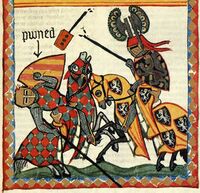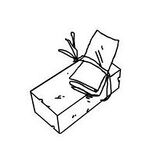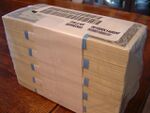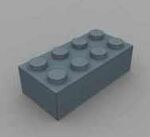Brick
“I may make you feel but I can't make you think”
The brick is the icon of solidity in modern commerce. A business touts itself as being "solid as a brick" — especially when this is utterly untrue. However, it is such an effective simile that it is used in many other senses in conversation. Politicians are often described as being as dumb as a brick. Many prefer this to the phrase "dumb as a doorknob," which might imply that they could be turned.
History
After millennia of having society's most skilled craftsmen sculpt rocks into the shape of bricks, and having its hunters and gatherers hunt for and gather rocks that were naturally in the shape of bricks, it fell to the primitives in the Indus Valley to mix clay into forms in the shape of bricks and let it dry. The equally primitive Aztecs allowed adobo to dry and cut it in the shape of bricks in hopes of building edible homes.
There are twists and turns in any advancing technology, and prehistoric man briefly digressed into frightening his cave-mates so that they might "shit bricks." But this could not be ramped up into production quantities.
It took mere hundreds of years of job actions and internecine warfare for the craftsmen, hunters, and gatherers to concede that the modern methods were preferable. This marked the start of history's brick era.
The basis for the brick era was the scholarly work of the Three Little Pigs. Porcine science compared brick structures to other common building materials of the day and found that brick houses survived more huffing-and-puffing wolf attacks in 100% of the cases (n = 1).
It was not long before placid riverside cottages made of wood were swept away to make way for huge, boxy woolen mills made of bricks. It was then that the brick era itself gave way to what is termed the noise era.
Much later, at the dawn of the information era, bricks were the most common medium of communication. A message attached to a brick (pictured) could be thrown much further than the piece of paper itself. (Pupils learn in Physics class that this is not true on the surface of the moon, and paper and bricks travel through vacuum at the same speed. This is why so many second homes on the moon are built of paper.)
When the information era led to investment "bubbles," the public demanded government regulation. This began the goldbrick era.
Bricks in modern culture
Brick shit-house
It is often said of a well-endowed woman that "she is built like a brick shit-house." This despite the fact that few shit-houses are built of bricks, and the other fact that the expression is far from flattering, and the still other fact that a brick shit-house would not be soft and curvaceous but hard and with well-defined angles. Yet no one says that Twiggy, the emaciated fashion model whose only "six-pack" was a rib cage, was built like a brick shit-house.
Bricks and mortar
Successful stores such as Radio Shack and Best Buy are touted as "bricks and mortar," to portray them as preferable to web commerce.
Of course, for the rare customer who does not go inside the bricks and mortar to try out a new gadget before buying it at half price through Amazon, these chains have websites of their own. In fact, their best salesmen, when asked any really hard question, tell the customer to Google the answer for themselves. And when a customer arrives describing a deal on the company's website, the salesman discloses that the website has nothing to do with the store, the store doesn't stand behind any promise it makes on the website, and you would be better off buying something different from what you came in to buy.
These are some of the reasons it is such a winning formula to open "bricks and mortar" stores.
The future of bricks
Some day, bricks will not be made of bricks but of modern synthetic materials. Avant-garde nations such as Denmark will lead the way, build entire cities of such bricks, and claim to be "saving the planet." These cities will withstand freezing weather better than cities built of kiln-dried bricks. However, they will still be overrun by the Germans on Day One of any future armed conflict.
In the far future of science fiction, a way will be found to occlude the unsightly round knobs on the top of every brick.



